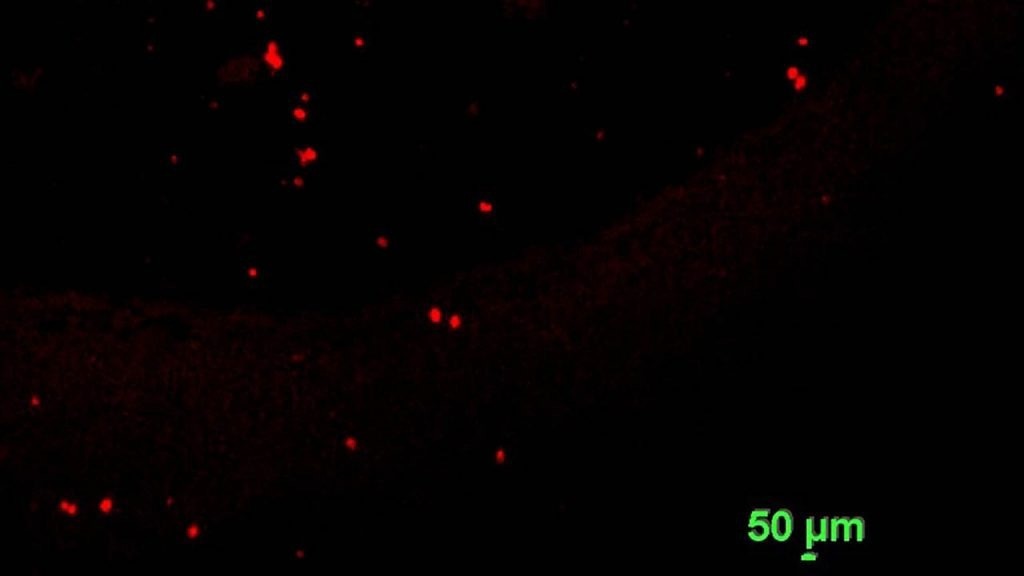Microplastic pollution in Auckland’s air seems to be comparable to millions of plastic bottles.

Microplastics visible after the application of dye. The scale is 50 microns, or 0.05 of a millimeter. Image Credit: University of Auckland.
At the University of Auckland, scientists assessed that 74 metric tons of microplastics are dropping ffrom the air into the city per year, the equivalent of more than 30 lakh plastic bottles falling from the sky.
The study, reported in the journal Environmental Science & Technology, denoted that numerous microplastics present in Auckland’s air are of extremely small sizes. This increases worries about the ability of particles to be inhaled and housed in the human body.
Throughout the world, scientists might have considerably undercounted airborne microplastics, states lead author Dr. Joel Rindelaub of the School of Chemical Sciences at Waipapa Taumata Rau, University of Auckland.
The levels discovered in Auckland’s air were several times greater compared to those recorded in London, Hamburg, and Paris in the past few years. This was because researchers in the new study made use of advanced chemical methods to determine and examine particles that measure those as small as 0.01 of a millimeter.
The mean (average) number of airborne microplastics that were detected in a square meter in a day was 4,885. This is in comparison with 771 in London (reported in a study published in 2020), 275 in Hamburg (2019), and 110 in Paris (2016).
Future work needs to quantify exactly how much plastic we are breathing in. It’s becoming more and more clear that this is an important route of exposure.
Dr. Joel Rindelaub, Study Lead Author, School of Chemical Sciences, Waipapa Taumata Rau, University of Auckland
The study is the first to evaluate the entire mass of microplastics present in a city’s air.
The waves that break in the Hauraki Gulf might play a primary role in Auckland’s issue by moving water-borne microplastics into the atmosphere.
The production of airborne microplastics from breaking waves could be a key part of the global transport of microplastics. And it could help explain how some microplastics get into the atmosphere and are carried to remote places, like here in New Zealand.
Dr. Joel Rindelaub, Study Lead Author, School of Chemical Sciences, Waipapa Taumata Rau, University of Auckland
Particle sizes altered with wind direction. When winds passed over the Auckland city center, the microplastics downwind were bigger. This inferred that the plastics had gone through less environmental aging and were obtained from a closer source.
Polyethylene (PE) was the significant substance that was detected, tracked by polycarbonate (PC), and polyethylene terephthalate (PET). Polyethylene and PET are packaging materials, while PC is utilized in electrical and electronic applications.
In the research performed, microplastics falling from the air were caught by a funnel and jar present in a wooden box on a rooftop at the central city University campus. A similar set-up was placed in a residential garden present in Remuera.
Nearly all of the microplastics were too small to be viewed by the naked eye. Scientists determined the smallest particles by employing a colored dye that discharged light under certain conditions. Heat treatment was utilized to analyze mass.
The smaller the size ranges we looked at, the more microplastics we saw. This is notable because the smallest sizes are the most toxicologically relevant.
Dr. Joel Rindelaub, Study Lead Author, School of Chemical Sciences, Waipapa Taumata Rau, University of Auckland
Nanoplastics, the smallest particles, have the possibility to enter cells, cross the blood-brain barrier, and might build up in organs like the liver and brain.
“Microplastics have also been detected in human lungs and in the lung tissue of cancer patients, indicating that the inhalation of atmospheric microplastics is an exposure risk to humans,” the paper says. Also, plastics have been detected in the placenta.
The study has been co-authored by Professor Kim Dirks, Dr. Patricia Cabedo Sanz, and Associate Professor Gordon Miskelly. This calls for standardization of reporting metrics so studies of airborne microplastics can be made with better comparisons.
The paper’s introduction stated, “Over the last 70 years, 8.3 billion metric tons of plastic have been produced globally. Only nine percent have been recycled, with the rest either incinerated or released into the environment.”
The experiment was performed over nine weeks during September, October, and November 2020.
Journal Reference:
Fan, W., et al. (2022) Evidence and Mass Quantification of Atmospheric Microplastics in a Coastal New Zealand City. Environmental Science & Technology. doi.org/10.1021/acs.est.2c05850.